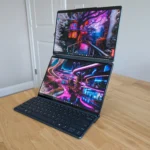The handheld gaming PC market is on fire, with various companies vying for the attention of gamers on the go. Lenovo is the latest contender to join the race with its Legion Go, set to hit the market in October. With an 8.8-inch QHD Plus screen, an AMD Ryzen Z1 Extreme processor, and some unique features, the Legion Go has certainly caught our attention.
A Hybrid of Sorts

The Legion Go seems to bridge the gap between the Nintendo Switch and Asus’ ROG Ally, offering a mix of portability and performance. Priced starting at $699, Lenovo appears to be targeting the Ally’s price point. However, it’s not just about the cost; it’s also about what this handheld can do.
Size Matters

The Legion Go is a tad heavier than its competitors, such as the ROG Ally and Steam Deck. It’s a noticeable difference, especially for those who plan to carry it around frequently. While the extra weight might not impact gaming when propped up with the kickstand, it’s worth considering if you’re looking for maximum portability.
However, this added bulk does bring an advantage: battery life. Lenovo has opted for a larger battery, which could result in extended gaming sessions compared to some slimmer competitors. Unfortunately, Lenovo hasn’t provided an estimated battery life yet, but we hope to get more details closer to the October launch.
Impressive Specs
The Legion Go boasts an impressive 2560 x 1600 resolution screen with a 144Hz refresh rate. Inside, you’ll find 16GB of LPDDR5X RAM and up to 1TB of storage. It comes equipped with a variety of ports, including a 3.5mm audio combo jack, a USB-Type C (USB 4.0, DisplayPort 1.4, Power Delivery 3.0), and a microSD reader. There’s also an additional USB Type-C port on the bottom.

Gaming Experience
During the hands-on experience, we tried a few games, including PowerWash Simulator, Quake II, Evil West, and A Short Hike. Lenovo appears to be targeting a 15W default setting for the Legion Go. The gaming experience was generally smooth, with responsive controls and minimal fan noise.
However, there was a significant issue we encountered: game controls. Some games prompted us to press keys that the Legion Go simply doesn’t have. For example, being told to press “Escape” when there’s no Escape key is a major problem. Lenovo representatives acknowledged this and stated they would address these control mapping issues before launch.
Windows Compatibility Challenge
The biggest question surrounding the Legion Go is its compatibility with Windows. Unlike some competitors, this device doesn’t run a specially optimized version of Windows for handheld gaming. It’s running the regular old operating system. While navigation with the touchpad or touchscreen was functional, it felt less than ideal compared to using joysticks.
This challenge isn’t unique to the Legion Go; many Windows-based handheld gaming PCs face it. Windows isn’t optimized for this form factor, and navigation can be cumbersome. The success of the Legion Go may depend on Lenovo’s ability to make it work seamlessly with Windows, particularly the user interface and control mappings.
Lenovo’s Legion Go brings a compelling option to the handheld gaming PC market. With a competitive price, robust specs, and a unique form factor, it has the potential to attract gamers. However, the device’s success will hinge on how well it integrates with Windows and whether Lenovo can iron out the control mapping issues. As the launch date approaches, we’ll be keeping a close eye on the Legion Go to see if it can truly shine in this competitive arena.
See full specs below,
| Lenovo Legion Go | |
| Dimensions (L x W x H) | Base Module: (mm): 210mm x 131mm x 20mm (inches): 8.27″ x 5.15″ x 0.79”Base Module w/ Controllers Attached: (mm): 299mm x 131mm x 41mm (inches): 11.8” x 5.15” x 1.61” |
| Weight | Controllers Detached: 640g (1.41lbs)Controllers Attached: 854g (1.88lbs) |
| Color | Shadow Black |
| Display8 | 8.8” QHD+ (2560 x 1600) IPS; 16:10 10-point Touch (144Hz / 97% DCI-P3 / 500nits / 83%AAR |
| Touchpad | Multi-finger |
| Processor8 | Up to AMD Ryzen Z1 Extreme with AMD RDNA Graphics |
| Memory | 16GB 7500Mhz LPDDR5X on board |
| Storage1,8 | 256GB / 512GB / 1TB PCIe 4.0 NVMe M.2 22428 |
| Operating System | Windows 11 Home |
| Battery | 2-cell 49.2WHr Super Rapid Charge2 Controller battery capacity: 900mah2 |
| Power Adapter | USB Type-C, 65W AC adapter Output: 20V DC, 3.25A, 65W Input: 100~240V AC 50/60 universal |
| Ports | Top – 3.5mm audio combo jack – 1 x USB Type-C (USB 4.0, DisplayPort™ 1.4, Power Delivery 3.0) – 1 x microSD card reader Bottom – 1x USB Type-C (USB 4.0, DisplayPort 1.4, Power Delivery 3.0) |
| Control and Input | Gamepad Controls
Haptics: HD haptics |
| Audio | 2 x 2W Speakers Dual-array near-field microphone |
| Connectivity | 2 x 2 Wi-Fi 6E (802.11 ax)3 Starting from Bluetooth® 5.2 |
| Software | Legion Space Xbox Game Pass Ultimate – Complimentary 3-month membership4,5 |
Discover more from TechBooky
Subscribe to get the latest posts sent to your email.







